Sheet Music
listen while reading music
Let's take the plunge, and learn about sheet music! We'll make it fun!
Lines
Five horizontal lines are our musical canvas, where we place notes for a beautiful song. Line one is on bottom.
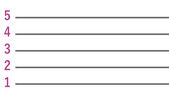
Here are the Lines' names:
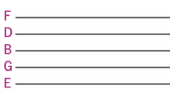
Next, remember line letters with the phrase, Every Good Boy Does Fine. Let's place notes (simple circles with lines) on our staff (5 lines).
Notes
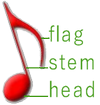
A Musical Note has a circle (head) and a line (stem). The note's shape represents its rhythm. Now, on whatever line we place a note, is the note's name.

Guess this note's name? It's F, and its stem points down. To keep the stem within the lines, the higher notes' stems are down, and the lower notes' stems are up.
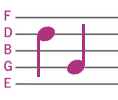
Here, we have both a D and G note. The Stem changes direction at the third line, B, the middle line. The B note itself has a downward stem.
In summary, Every Good Boy Does Fine helps remember the line names. The note stems have EG stems going up, and BDF stems going down.
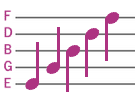
Spaces
Now, we'll study the spaces between the lines. They're easy to remember, as the spaces' names are FACE (rhyming with space).
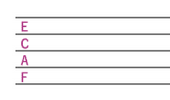
So, 5 lines and 4 spaces are between the lines. We'll add notes on the spaces:
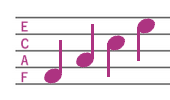
Notice the note stems are down for CE and up for FA. The circle (head) can be either filled or empty. Again, the look of a note gives the rhythm, but where the note is on the staff, gives its name.
The 5 lines and 4 spaces together is a Staff. You may already have noticed that the staff follows the alphabet, starting from the bottom line, EFGABCDEF. From bottom to top is lowest to highest sounds.

Every Good Boy Does Fine for Lines, and FACE for Spaces. EFGABCDEF are the notes' names on a staff.
Measures of Rhythm
For a basic concept: Page5 (note division)
The letters' placement on a staff represents a tone. But music is rhythm as well as sound. Notes' shape changes for different rhythms (durations, or lengths) of sound. Different counts have different note shapes. Take a look at the whole note. It's basically an open circle.

This whole note occupies the D line, so it's a whole D note. How long is the D note played? We'll discuss measures to find out:

Songs are easier to learn if we break them up into small pieces of sound. These pieces have equal durations, or lengths. They're like sidewalk squares, that, when you walk across many of them, you reach the end. But together, they make up the whole slab of sidewalk.
This sidewalk song has lines that divide the sounds into equal lengths. These are Measures that have a vertical bar line to divide the sound pieces. When you play (walk) through all the measures, you've reached the end of the song.

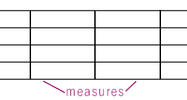
We can have as many measures as we need, if we keep adding bar lines. Measures hold a certain number of beats, or equal counts. The beats can be in groups of two, three, or four (like taking different numbers of steps within the squares).
Notes' Count

Whole Note
A whole note takes up the whole measure, or count (if we're counting in four, since the whole note gets 4 beats). We hold that tone until the measure's count is complete. So, the above whole D lasts until we enter the next measure.
Music, then, is simultaneously tones and rhythm. The shapes of the notes tell us how long (duration) to play the tone, and the bar lines (measure length) group notes in equal counts.
Half Note
Next, dividing a whole note produces a half note, that's an open circle with a stem. If there's only one whole note in a measure, logically, there will be two half notes in a measure of the same count.

For example, if the measure was in a beat of four(4), the whole note would get 4 beats total. The two half notes would receive two beats (counts) each. Just remember that the whole note gets all the counts, and the half notes get half of that.
Quarter Note
Now, half of a half note is a quarter note. They're called quarter notes, because quarter means four(4), and there are 4 quarters in a whole. This quarter note is a closed (filled) circle with a stem.

The 4 quarter notes in the measure above are 4 beats. Since the notes are equal in length (duration), the measure holds 4 equal beats. The beat is counted 'one and' (the first beat starts on the downbeat). While tapping our foot, we can start counting the measure as, 'one and, two and, three and, four and', or:
1& down up | 2& down up | 3& down up | 4& down up
The next measure's first beat ends the previous measure's last beat.
Eighth Note
Equally dividing notes creates other types of notes. The type of note that divides the quarter note in half, is called an eighth note. An 1/8th, or eighth note, divides a whole note eight times. So, a whole measure has eight eighth notes. The eighth note has a closed circle and a stem, with a flag connected to the end of the stem.

Notice that each eighth note falls on either a downbeat, or an upbeat, when counting:
Each eighth note gets a half of a beat (a half of a quarter note). So, with each division of notes (whole, half, quarter, eighth), we add more notes to complete the measure. And as we add more notes, the notes get smaller in duration, or length of time. The tones become shorter with more notes per measure.
Each note is played or sung for a whole, half, quarter, or eighth of a measure, with how many other notes it takes to finish the measure's count. We can mix them, as long as they equal the measure's count (in this case, four beats).
Therefore on the staff, where we place a note is a tone of sound. A type of note is the time duration to hold a sound.

| Beat Counts | |
|---|---|
| Whole | = 4 |
| Half | = 2 |
| Quarter | = 1 |
| Eighth | = 1/2 |
The next page counts the rests between sounds. Rests are divided into the same increments as notes.